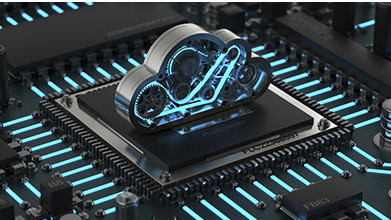Cloud native EDA tools & pre-optimized hardware platforms
Synopsys Cloud
Unlimited access to EDA software licenses on-demand
In the past, an organization’s computing power almost always resided in a centralized data center. As networks have grown more distributed to include remote systems and applications—such as IoT devices, smart environments, and cloud software—centralized data processing has become less efficient. Edge computing moves processing power closer to the sources of data at the network edges so that data doesn’t need to be routed to and from a centralized location, reducing latency and improving the efficiency of data processing.
This article examines edge computing benefits in greater detail and discusses how to overcome some common challenges.
Top Edge Computing Benefits
Gartner predicts that 75% of enterprise-generated data will be created and processed outside of a centralized data center or cloud environment, up from 10% in 2018. Let’s look at the top edge computing benefits driving this rapid adoption.
Reduced Latency and Improved Performance
The time it takes for data to travel to and from the processing systems is known as latency, and it’s a leading cause of performance issues like slow speeds and timeouts. Edge computing occurs very close to the source of data collection, so that data doesn’t have to travel very far. This reduced latency improves the speed and performance of the applications that rely on edge data, such as cloud native EDA tools.
Improved Security and Data Privacy
Centralized data centers are a high-value target for hackers and other cybercriminals because they store and transfer large quantities of sensitive data. Edge computing keeps data dispersed around the edge of your network, so no single device holds too much valuable information. This makes edge compute systems less tempting to hackers and limits the damage if an edge device is breached.
High Resiliency
In a centralized network, all data must flow through data processing servers in a data center, which creates a single point of failure for all the systems and applications that rely on that processing power. If there’s an equipment failure or network outage at the data center, everything grinds to a halt. Edge computing relies on many different processing systems distributed geographically and logically, which means one can fail without affecting all the rest. This improves the reliability and resiliency of the entire enterprise network.

Increased Scalability
Scaling up a large data processing server in a centralized data center can be highly disruptive because these systems power so many business-critical workflows and applications. Servers may need to shut down or restart to install new hardware, and a mistake in the software upgrade process could extend the downtime even longer. Because each edge computing system is only responsible for a limited number of data sources and only affects a small corner of your network, scaling and upgrading this infrastructure isn’t as disruptive or risky.
Operational Cost Savings
In a centralized architecture, the large quantities of data generated by edge devices must be transferred to the data center over the internet, using a lot of bandwidth. Since most ISPs and data centers have a usage-based pricing model, and the amount of data created at the edge will only continue to grow over time, this can drive operational costs through the roof. In an edge computing architecture most edge data stays on the local network (LAN), reducing your bandwidth usage and keeping costs under control.
Edge Computing Challenges
While there are many ways that edge computing benefits organizations that collect and process significant amounts of data from edge devices, this type of architecture also presents a few challenges.
Ensuring Adequate Network Bandwidth
Edge computing reduces the bandwidth load between the centralized data center and edge locations but increases the bandwidth load on individual edge LANs. To take full advantage of edge computing, you must allocate more bandwidth to edge locations and use LAN infrastructure capable of supporting this bandwidth (e.g., gigabit routers and switches).
Decentralizing Security Policies and Controls
Decentralizing your data processing reduces risk, but edge computing also creates new security challenges. It’s harder to build a strong defensive perimeter of security policies, tools, and controls when so much computing occurs outside of the core network. One way to overcome this challenge is to use cloud security tools that can apply role-based access control (RBAC) policies, firewall rules, and other protections consistently across your core and edge network no matter where the user, device, or application resides.
Reducing Management Complexity
When all of your data processing systems live in one place, it’s easier for administrators to monitor, manage, and optimize them. When you move and disperse these computing resources around the edge, management becomes more complex, increasing the chances that an administrator will make a costly mistake or miss a critical issue. For edge computing to be most effective, you need to implement a centralized monitoring and orchestration solution that unifies edge system management behind a single interface.
Edge Computing Benefits for Chip Design
Cloud-native electronic design automation (EDA) tools are more innovative, scalable, and high-performing than on-premises tools. Edge computing benefits chip designers by allowing users and devices at the edge of your network to connect directly to EDA tools in the cloud, improving the performance of those tools and the overall user experience.
Synopsys, EDA, and the Cloud
Synopsys is the industry’s largest provider of electronic design automation (EDA) technology used in the design and verification of semiconductor devices, or chips. With Synopsys Cloud, we’re taking EDA to new heights, combining the availability of advanced compute and storage infrastructure with unlimited access to EDA software licenses on-demand so you can focus on what you do best – designing chips, faster. Delivering cloud-native EDA tools and pre-optimized hardware platforms, an extremely flexible business model, and a modern customer experience, Synopsys has reimagined the future of chip design on the cloud, without disrupting proven workflows.
Take a Test Drive!
Synopsys technology drives innovations that change how people work and play using high-performance silicon chips. Let Synopsys power your innovation journey with cloud-based EDA tools. Sign up to try Synopsys Cloud for free!
About The Author
Gurbir Singh is group director, Cloud Engineering, at Synopsys. He has a demonstrated history of leadership in the software industry. In his current role, he leads the development of the Synopsys Cloud product, which enables customers to do chip design on the cloud using EDA-as-a-Service (SaaS) as well as flexible pay-per-use models. Gurbir has run organizations to develop cloud SaaS products, machine learning applications, AI/ML platforms, enterprise web applications, and high-end customer applications. He is experienced in building world- class technology teams. Gurbir has a master’s degree in computer science, along with patents and contributions to publications.











